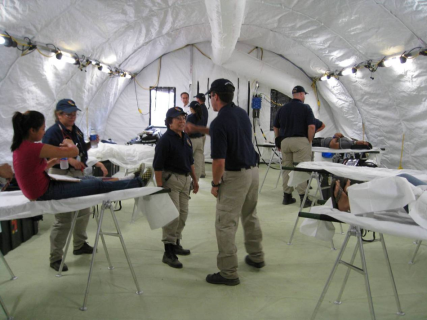Disaster Medical Services Division
Ambulance Strike Teams (ASTs): ASTs are positioned throughout the State to support local emergency medical service response, including medical transportation. There are both pre-designated and undesignated ASTs in California. Pre-designated ASTs are under contract with EMSA and consist of 5 ambulances and 1 Disaster Medical Support Unit (DMSU). The DMSU provides enhanced communication ability to support field deployment, including medical supplies and provisions for AST personnel. Use of the DMSUs and a requirement to provide ASTs is by contract with EMSA. Undesignated ASTs are organized at the local level and are not under contract with EMSA, although they may respond to requests from EMSA in times of need.
California Medical Assistance Team: CAL-MATs are deployable teams that support specialized health response needs such as disaster triage sites, clinics, medical shelters and hospitals including mobile field hospitals. EMSA maintains oversight of warehouse operations and cache management including vehicles, equipment and supplies, and coordinates team formation and response. The size of the team is determined by the medical mission.
Disaster Healthcare Volunteers (DHV): DHV is a program that registers and credentials health professionals who may wish to volunteer during disaster including doctors, nurses, paramedics, pharmacists, dentists, mental health practitioners, etc. DHV may be used by local officials to support a variety of local needs, including augmenting medical staff at healthcare facilities or supporting mass vaccination clinics. DHV is California’s Emergency System for the Advance Registration of Volunteer Health Professionals (ESAR-VHP).

Exercises and Training: EMSA participates in and provides a variety of exercises and trainings to test and refine plans, policies and procedures. This includes the annual Statewide Medical and Health Exercise, developed in partnership with the California Department of Public Health.
Hospital Incident Command System (HICS): The Hospital Incident Command System (HICS) is an incident management system that can be used by any hospital to manage threats, planned events, or emergency incidents.

Medical Reserve Corps (MRC): The MRC is a national network of volunteers organized locally to improve the health and safety of their communities. MRC volunteers include medical and public health professionals and other community members. MRC units engage these volunteers to strengthen public health, improve emergency response capabilities and build community resiliency. They prepare for and respond to natural disasters such as wildfires, hurricanes, tornados, blizzards, and floods, as well as other emergencies affecting public health.

Mission Support Teams (MSTs): MSTs provide logistical support to deployed mobile medical assets maintained by EMSA and are the coordination conduit between the requesting local jurisdiction and the deployed asset(s). Coordinated by EMSA, MSTs may consist of State, local government, and/or private sector personnel. The size of the MST is determined by the medical mission.

Plans: Based on EMSA’s responsibilities described in the California State Emergency Plan, DMS both develops a variety of disaster medical response plans and participates in the development of more comprehensive catastrophic event response plans. These include:
- The California Public Health and Medical Emergency Operations Manual
- California Patient Movement Plan
- Catastrophic Event Response Plans focusing on various geographic areas, such as the Bay Area, Cascadia Subduction Zone, Northern California Floods, and Southern California.
Regional Disaster Medical Health Coordination (RDMHC) Program: A comprehensive program under the direction of the Regional Disaster Medical and Health Coordinator that supports information flow and resource management during unusual events and emergencies. This program includes the Regional Disaster Medical and Health Specialist (RDMHS). The RDMHS directly supports regional preparedness, response, mitigation and recovery activities. EMSA contracts with six LEMSAs to fulfill the duties of the RDMHS as described in the scope of work.
Response Resources: The DMS Response Resources Unit maintains EMSA’s mobile medical assets program. This includes bio-medical equipment maintenance and resupply of expired and recalled medical supplies in caches of all mobile medical assets.






